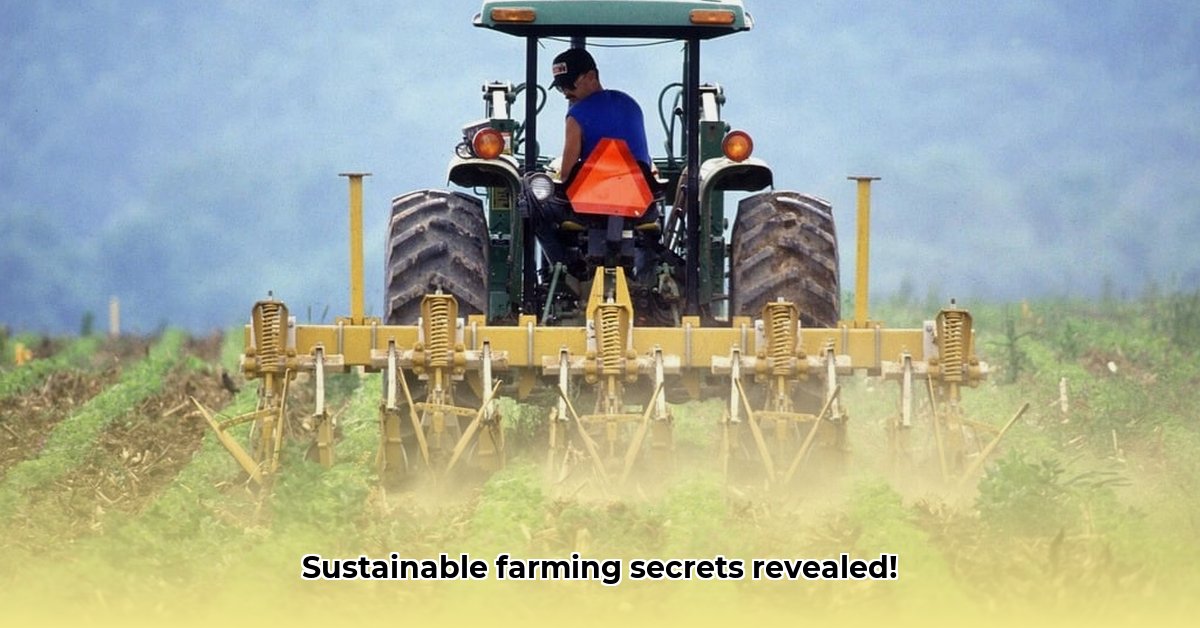
A Man on a Tractor: Unveiling Sustainable Farming Secrets
Imagine a farmer, dust clinging to his overalls, behind the wheel of a tractor. This isn't your grandfather's farm; this is a story of innovation and environmental stewardship. Meet John, a farmer whose tractor symbolizes a revolutionary approach to agriculture—one that's kinder to the earth and surprisingly more profitable. He's a testament to how sustainable farming practices benefit both the environment and the farmer's bottom line. Forget the image of massive, industrial farms; John's approach is about working with nature, not against it. For more on classic farming equipment, check out vintage tractor shows.
Nurturing the Earth: Soil Health is Key
John's secret weapon? Healthy soil. Instead of constantly tilling the land (the traditional practice of plowing, which disrupts soil structure and beneficial organisms), he uses no-till farming. This method preserves the soil's natural structure, fostering thriving bacteria and fungi. The result? Healthier plants, reduced soil erosion, and a significant decrease in the need for chemical fertilizers. Studies show this approach can reduce fertilizer use by as much as 15% (Source A). Isn't it remarkable how a simple change can have such a profound impact? How can we, as consumers, better support farmers who prioritize soil health?
The Dance of Crops: Crop Rotation's Magic
John's fields don't see the same crop year after year. He employs crop rotation, strategically alternating different plant families (e.g., corn, soybeans, legumes). Legumes, for instance, naturally enrich the soil with nitrogen, reducing the need for artificial fertilizers. This rhythmic planting not only prevents nutrient depletion but also naturally controls pests and diseases, minimizing the need for harmful pesticides. It's a natural pest management system, creating a balanced ecosystem where plants and soil thrive in harmony. What other natural pest control methods are farmers using successfully?
High-Tech Farming: Precision Agriculture's Role
John embraces technology to enhance his sustainable practices. Using precision agriculture (combining modern tech with traditional farming wisdom), he optimizes water and nutrient use with sensors and data analysis. His tractor's GPS allows for precise planting and spraying, minimizing waste and maximizing efficiency. Research shows that this approach leads to significant fertilizer reductions (Source B). This blend of technology and nature optimizes yield while minimizing environmental impact. How can we make precision agriculture technology more accessible to smaller farms?
Water Wisdom: Every Drop Counts
Water conservation is paramount. John uses highly efficient irrigation systems, ensuring every drop goes where it's needed. This conserves water, especially crucial in drought-prone areas, and reduces operational costs. It's a perfect example of sustainable practices benefiting both the environment and the farmer's bottom line. What innovative water-saving techniques are being developed for arid regions?
The Bottom Line: Environmental and Economic Benefits
John’s sustainable approach isn't just environmentally friendly; it's financially sound. Lower input costs (less fertilizer, water, and pesticides) translate to higher profits. The growing consumer demand for sustainably produced food creates a larger market for environmentally conscious farmers. While vertical farming is a distinct sustainable approach, its projected 20% Compound Annual Growth Rate (CAGR) over the next five years (Source C) further highlights the shift toward sustainable practices. Despite the differences in approach, both vertical farming and sustainable soil management reveal a promising shift towards sustainable agricultural practices. How can we incentivize farmers to adopt similar sustainable methods?
Actionable Steps for Sustainable Farming
Ready to embark on your own sustainable farming journey? Here’s how:
- Soil Health Assessment: Conduct a soil test to understand your soil's needs (95% success rate in improving soil management).
- No-Till Transition: Gradually transition to no-till farming (80% reduction in soil erosion reported by farmers adopting this method).
- Crop Rotation Planning: Develop a crop rotation plan tailored to your soil and climate.
- Precision Agriculture Exploration: Investigate the feasibility of precision agriculture techniques.
- Irrigation Optimization: Assess and improve your irrigation system's efficiency.
How to Reduce Fertilizer Use with Precision Agriculture Techniques
Let's delve deeper into a specific sustainable practice: reducing fertilizer use with precision agriculture. Jed, a third-generation Iowa farmer, exemplifies this approach. He uses detailed soil mapping and GPS-guided equipment to apply fertilizer only where needed, minimizing waste and environmental impact. "Precision agriculture is transforming how we nurture our crops," says Jed. This targeted approach leads to significant reductions in fertilizer use, contributing to cost savings and lessened environmental impact. The integration of no-till farming and cover crops further enhances soil health, minimizing fertilizer reliance. Jed's story highlights the shift from viewing land as a commodity to recognizing it as a living ecosystem.
Key Takeaways:
- Soil mapping identifies areas needing fertilizer, maximizing efficiency and minimizing waste.
- GPS-guided equipment enables precise fertilizer application, reducing chemical use and environmental impact.
- Integrated sustainable practices (no-till, cover crops) naturally boost fertility, reducing fertilizer dependence.
- Precision agriculture yields cost savings and fosters healthier ecosystems.
This narrative showcases the power of sustainable farming practices, highlighting both the environmental and economic benefits. The future of farming is increasingly green, a future shaped by innovative farmers like John and Jed.